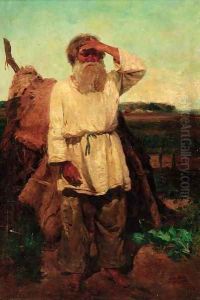Sergei Vasil'evich Maliutin Paintings
Sergei Vasil'evich Maliutin was a Russian painter, architect, and stage designer who played a significant role in the folk art movement of his time. Born on October 4 (O.S. September 22), 1859, in Moscow, Maliutin was exposed to the rich cultural heritage of Russia from an early age, which deeply influenced his artistic direction.
Maliutin studied at the Moscow School of Painting, Sculpture, and Architecture, where he honed his skills in painting and architecture. He was greatly inspired by traditional Russian folk art and culture, which would become a central theme throughout his career. Maliutin was a contemporary of many influential artists of the Russian Revival, a movement that sought to rediscover and rejuvenate Russian national culture in the late 19th and early 20th centuries.
One of Maliutin's most enduring contributions to Russian culture is his design of the first Russian matryoshka doll, the now-famous set of wooden nesting dolls, in 1890. The creation of the matryoshka was a collaborative effort between Maliutin and the craftsman Vasily Zvyozdochkin, stemming from Maliutin's interest in toy making and folk art. The original set depicted a peasant woman holding a rooster, with subsequent dolls representing her children, diminishing in size.
Throughout his career, Maliutin was involved in various artistic endeavors, including designing sets and costumes for theater productions, which further showcased his versatility and creativity. His architectural projects reflected his commitment to incorporating traditional Russian styles into his work.
Maliutin's role as an educator was also significant. He taught at the Stroganov Moscow State University of Arts and Industry, influencing a new generation of artists and designers. His legacy extends beyond his individual works and into the broader revival of appreciation for Russian folk traditions in art and design.
Sergei Maliutin passed away on December 6, 1937, leaving behind a body of work that continues to be celebrated for its vibrant portrayal of Russian folk culture. He remains a respected figure in the history of Russian art, particularly for his contribution to the nationalistic movement that sought to define a distinctly Russian artistic identity separate from Western European influences.
